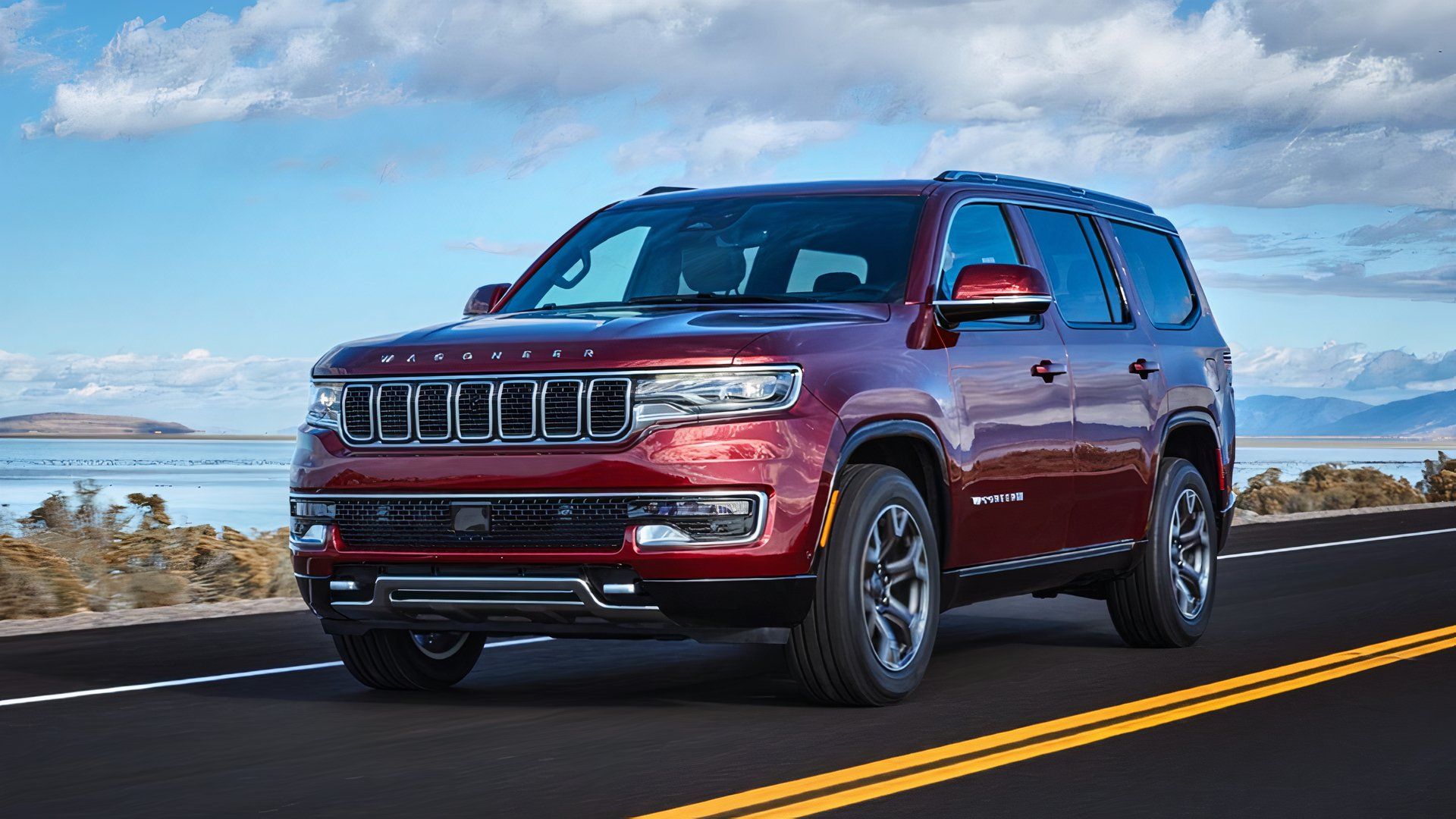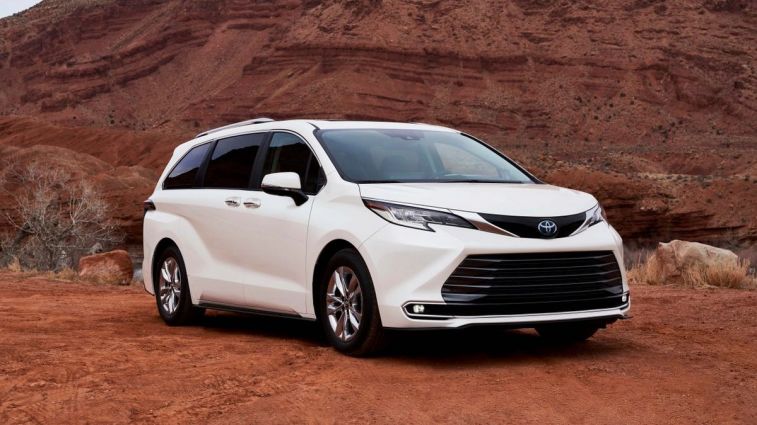Jeep Grand Wagoneer
Price Range: $89,995-$109,995

You can’t find a Jeep Grand Wagoneer for less than $90,000 in 2024, but if you turn to the 2022 model year, it’s possible to find one of these SUVs under that price. The base model’s starting MSRP butted right up against this figure in 2022.
Pros
- Quadra-lift air suspension
- Electronic limited-slip rear differential
- Upscale interior with top-quality materials
Cons
- Looks too much like the regular Wagoneer
- Poor fuel economy
- Bulk makes maneuverability challenging
Powertrain Specifications
| Engine | 6.4-liter V8 |
| Transmission | 8-speed automatic |
| Horsepower | 471 hp |
| Torque | 455 lb-ft |
| Driveline | RWD, 4WD |
| Fuel Efficiency | 13/19 mpg, 13/18 mpg |
| Towing Capacity | 9,850 pounds |
Every trim of the 2022 Jeep Grand Wagoneer comes with a strong 6.4-liter Hemi V8 engine under the hood, giving you an impressive level of power for the drive. This was the first model year for this big SUV, and it’s evolved since then, but you can’t find a new version for less than $90,000.
Pricing By Trim
| Trim | MSRP |
| Series I | $89,995 |
| Series II | $99,995 |
| Obsidian | $105,490 |
| Series III | $109,995 |

To say today’s SUVs and minivans drive safer than those of, let’s say, 15 years ago isn’t nonsense. Not only did the recent crop of advanced safety features find their way into both segments, but the materials forming the vehicle structures of today are stronger.
Moreover, techniques to direct the force of crashes to areas of the frame and body where it will do the least harm constantly evolve and improve. Yes, today’s SUVs and minivans drive safer than those of decades past.
However, the war isn’t won. Crashes still happen, injuries occur, and lives get lost on the streets, roads, and highways every day. Although it represents about a 4% decrease from 2022, the National Highway Traffic Safety Administration (NHTSA) estimates that 40,990 people died in traffic accidents in 2023.
The reality is that some SUVs and minivans provide a better chance of walking away from a crash or avoiding one altogether than others. Those are the vehicles on our list. Read on to learn which SUVs and minivans we consider the safest and why.
- Picking the SUVs and Minivans: Methodology
- Vehicle Crash and Safety Testing
- The Safest SUVs List
- The Safest Minivans List
- IIHS TSP Award Winners
Picking the SUVs and Minivans: Methodology
We based our safest SUVs and minivans list on those with high crash test and safety scores from NHTSA and the Insurance Institute for Highway Safety (IIHS). Both organizations evaluate the safety of vehicles through crash and safety testing. We go into more detail about how they conduct those tests below.
Now, we have the list of what the IIHS and NHTSA believe are the safest models. However, we took the list a step further. We narrowed our picks to a specific trim level within each model, providing the most standard and available advanced safety technology and features. We also weighed the level of safety equipment against price to determine the best safety value.
Several safety features we take for granted, like stability control, traction control, tire pressure monitors, and antilock brakes, are now government-mandated. Federal law requires carmakers to make them standard for every new car, light truck, minivan, and SUV.
The government also mandates airbags. However, that mandate only includes the two front airbags to protect the driver and front passenger. Many of today’s passenger vehicles provide at least six airbags. In addition to the two front airbags, you also find two front side-impact and two side curtain airbags. Every model on this list has at least six airbags. We note those models with more than six.
Advanced Safety Technologies

We are convinced that advanced driver-assistance systems (ADAS) are critical for the safety of you and your family when in your SUV or minivan. In research published in August 2023, AAA reported that 37 million crashes could be prevented over the next 30 years with the widespread adoption of ADAS. Moreover, preventing those millions of crashes could save 250,000 lives while preventing 14 million injuries. Consequently, ADAS ranks high in our consideration when picking our list of safest SUVs and minivans.
To determine the safest trim-level value within each model, we balanced the price against the safety content in the vehicles. We looked closely at the advanced active safety technologies and other features providing an extra degree of protection. Among the active advanced safety features we considered include forward collision warning, automatic emergency braking, and rear cross-traffic alert. Other features we believe contribute to the safe operation of an SUV and minivan include LED headlights, an auto-dimming rearview mirror, and a head-up display.
Key Advanced Tech in Vehicles
Here’s the list of the more prominent advanced safety and driver-assistance technologies we looked for. Different carmakers have various names for the technologies we list here; however, we use popular industry names.
- Adaptive Cruise Control (ACC): Once locked in, adaptive cruise control maintains a preset speed. However, it also responds to the changing speed of the vehicle ahead. As it slows, so does your vehicle. Some systems bring your vehicle to a complete stop if necessary. Traffic Jam Assist is a form of adaptive cruise control. It’s engineered specifically for slow-moving, stop-and-go city traffic.
- Adaptive Front Lights: Swiveling in the direction in which the front wheels turn, these headlights light the way when taking a curve or making a turn.
- Automatic Emergency Braking (AEB): Usually paired with forward collision warning, AEB senses when your vehicle is likely to strike an object in front of it and automatically applies the brakes. The IIHS requires AEB for its Top Safety Pick (TSP) and Top Safety Pick+ (TSP+) qualifications, so we don’t cite it in our model descriptions.
- Blind-Spot Monitoring (BSM): Designed to detect and warn you of vehicles entering the outboard-mirror blind spots on your vehicle’s flanks, BSM uses sensors mounted on the corners of the rear bumper to detect approaching vehicles.
- Driver Monitoring System (DMS): Employing cameras and other sensors, DMS determines if a driver’s attention is still on the road. Some manufacturers call this Driver Awareness Alert.
- Forward Collision Warning (FCW): Using a camera or a combination of camera and radar, FCW detects an impending frontal crash, sounding an audible alert. More sophisticated FCW systems include emergency braking in cases when the driver fails to respond to the warning. The IIHS requires FCW for TSP+ qualification; therefore, we don’t cite it in our model descriptions.
- High-Beam Assist: The headlight high beams are always engaged in vehicles with this system. The system automatically switches off the high beams when photosensors or a forward-pointed camera senses approaching headlights or taillights. It automatically switches them back on when no vehicle lights are detected.
- Junction-Turning Assist (JTA): Sometimes called “intersection-turning assist,” this system detects oncoming traffic when making a left turn in an intersection. It sounds a warning, with most systems also automatically braking the vehicle.
- Lane-Centering Assist (LCA): Using a forward-pointed camera, LCA reads the lane marking and keeps the vehicle centered. LCA is a proactive system that constantly makes small steering corrections to keep the vehicle centered in the lane.
- Lane Departure Warning (LDW): While monitoring the defining lines on the pavement outlining your driving lane, a front-pointed camera recognizes when you drift too near one of them. The system will issue an auditory warning if you don’t engage the turn signal. More sophisticated systems have steering assist, nudging you back toward the center.
- Lane-Following Assist (LFA): If lane markings aren’t clearly defined, LFA keeps your vehicle on the same course as the preceding vehicle.
- Lane-Keeping Assist (LKA): Similar to lane departure systems with steering assist, LKA doesn’t issue an auditory warning. Instead, also using a forward-pointed camera to keep track of lane markings, it reacts to a vehicle drifting toward a lane marking. It then initiates steering corrections to keep your vehicle within the lane boundaries.
- Park Assist: Sensors located on the rear or front bumper detect an object approaching when traveling at low speeds. When they do, the system sounds an auditory alarm. More sophisticated systems also provide automatic braking.
- Parking Assistance: These systems vary in their scope and name. However, they can usually parallel park or diagonally park the vehicle with little or no driver input.
- Pedestrian Detection: A more advanced version of forward collision warning, this system detects pedestrians and other vehicles.
- Rear Cross-Traffic Alert (RCTA): This alert warns of traffic crossing behind you when backing out of a parking space.
- Safe Exit Assist: Radar-based, this feature detects approaching traffic and prevents the door from opening while sounding a warning.
- Surround-View Camera: A series of at least four cameras grab images around the vehicle. The system knits these images together to present an overhead image of the vehicle and its surroundings. Some carmakers call this system a bird’s-eye view or 360-degree monitoring. This is helpful when maneuvering through tight spaces or parking.
- Traffic Jam Assist (TJA): This is low-speed adaptive cruise control for stop-and-go city traffic or heavy highway congestion.
- Traffic Sign Recognition (TSR): Capable of recognizing an array of common road signs, this system displays recognized signs on one of the display screens or the head-up display.



